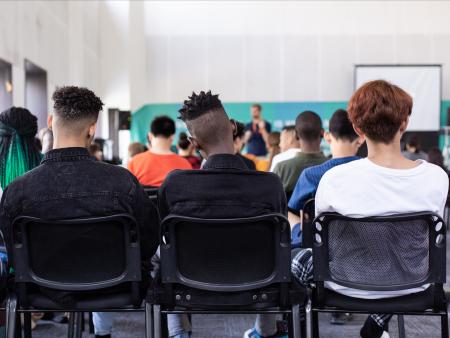
Addressing the Language: What do we mean by Integration?
Integration is a difficult word to grapple with. Through policy and government agenda, the word integration has come to be associated with the word ‘assimilation’.
But integration is not the same as assimilation.
It is not a pressure to downplay your culture. It is feeling a sense of belonging whilst holding your own unique identity. Every person that makes up a society is different, and we need to celebrate these differences.
But who is integration for? Who is it that needs to be integrated? Most people would automatically think of newly arrived communities. But integration applies to everyone. It applies when you move to a new city, if your circumstances change, if you experience barriers.
We need ask the question: what do we mean when we talk about ‘integration’?
Claiming and reclaiming words
Although it may appear that words are neutral and have a set meaning, words are fluid and have different meanings from person-to-person and context-to-context.
A word can be claimed and reclaimed. Using the word integration in the context of assimilation changes the way it is used and the meaning you come to associate with it. It can cause a word to have negative connotations in people’s minds. We need to rethink and reclaim the word integration.
Integration critiques
We must be careful that the word integration does not become conflated with assimilation. So often in public discourses, by politicians and newspapers, integration is used in place of assimilation.
But Integration is not assimilation.
Assimilation already assumes a nation has one, homogenous ‘British’ identity. It asks a person to attempt the impossible task of shedding parts of their identity. Assimilation is a toxic narrative; it is dangerously exclusionary and built upon an imagined myth of homogeneity.
You can assimilate aspects of a culture and still not be integrated. Integration is not about characteristics or identity. It is about how far you can be an active citizen and participate in society.
Communities are not built out of sameness. There have always been lines of difference. Young and old. Male and female. Rich and poor.
Community is built by meaningful connections, togetherness, dialogue and conversations.
INTEGRASS
In the UK Integration is not reserved only for newly arrived communities. The question we need to ask is: can anyone - even people born and brought up in the UK - be classed as fully integrated into society?
As society is not homogenous, it is impossible to be integrated into a whole country. Region to region our ability to be an active citizen would differ. For example, if a person from Glasgow moved to Cornwall, they would need to integrate into the local community in order to able to participate. They would need to learn where the nearest healthcare services were, when the rubbish gets collected and build up their social connections in a new area.
Through our ARIVE project, ACH has been working with partners to rethink how we can measure a person’s level of integration. It started by asking: when is a person considered to be integrated? What does integration feel like? Can integration be measured and tracked? The INTEGRASS toolkit assesses a person's level of ‘Integration’ by asking a person to read different statements and then judge how far they agree with them, in order to receive an overall score.
For example, these statements could be:
‘I am able to monitor my own expenditure’.
‘I understand how much money I am able to spend each month’.
‘I am able to introduce myself to my neighbours’.
‘I am involved in helping and supporting others.’
‘I eat fresh vegetables and fruit every day’.
How far can you agree with these statements?
Looking at integration this way makes you imagine integration as a scale, and not as two categories: integrated and not integrated.
Barriers to integration exist for many people. There are lines of inequality and other barriers that can prevent people from being integrated: mental health issues, a lack of literacy and numeracy skills, economic insecurity, social isolation and disability.
INTEGRASS shows us that no one is 100% integrated into society.
Integration or inclusion?
But what about the word inclusion? Inclusion is another word we often hear associated with integration.
We also need to tread carefully when we talk about inclusion. Inclusion can suggest there is a ‘we, the included’ and a ‘them, the excluded’. This gives ‘the included’ all the power to include or exclude.
If a person is ‘integrating’, they have the power to integrate themselves, to ‘self-integrate’. Through your own agency and self-direction you can work with others to integrate yourself into a society.
At ACH we provide integration services that allow newly arrived people to follow their own direction and make their own choices about their futures.
Reclaiming the word integration
Integration is a two-way street.
Everyone living in a society should have equal access to services, institutions and opportunities. This should not be dependent on background, race, gender, disability, age.
Everyone living in a society should have the ability to make their own choices: who to connect with, who to socialize with, what services to use, what career to strive for and where to live. Integration is about choice.
We should all be mindful of our own ‘integratedness’. Am I talking to my neighbours? Do I know how to access my local services? Am I monitoring my expenditure effectively?
Once you realise that integration is a scale, you question your own level of integration.
Integration is everyone’s responsibility. We should all be concerned with integration. Integration is a two-way street. We make our choices of who to connect with, which services we need to access and where to live – but these services, connections and choices should be accessible to everyone.
This is where ACH comes in. ACH provides integration services specific to the needs of refugees and migrants, helping to make opportunities accessible – from housing to employment skills training. Refugees and migrants face specific barriers to integration - language barriers, a lack of training opportunities, a lack of affordable housing – And ACH works to make these accessible.


